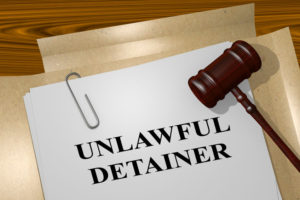Forcible Entry and Unlawful Detainer Law in Missouri

Under Missouri law, forcible entry and unlawful detainer occurs when a person unlawfully occupies real estate. Forcible entry and unlawful detainer lawsuits are typically filed to remove occupants following foreclosure and tenants after a lease terminates.
King Henry II
These laws are old. In 1166, the courts of King Henry II of England developed the first forcible entry and unlawful detainer laws. The primary purpose of these laws was to eliminate the violence that often occurred when owners tried to forcibly remove unlawful occupants. The owner simply needed to show that the owner’s right to possess the property was superior to the defendant’s right to occupy the property. This was typically shown by a deed. If the deed showed that the plaintiff was the owner, and that the occupant had no right to occupy the property, the court would order the occupant removed from the property. Importantly, these laws did not allow the defendant to challenge the validity of the deed, as the purpose of the law was to avoid violence, not litigate title issues.
Missouri Territory
In 1813, the General Assembly of the territory of Missouri enacted the territory’s first forcible entry and unlawful detainer statute, which was modeled after the English law. Like the English law, Missouri’s law did not allow the occupant to challenge the validity of the owner’s deed. The same prohibition exists today. So, if the occupant is a former owner who refuses to leave following a foreclosure, the occupant cannot assert in a forcible entry and unlawful detainer lawsuit that the foreclosure was done improperly. Likewise, an occupant cannot assert that the plaintiff obtained title through fraud, duress, coercion, or any other illegal means. Rather, the occupant must file a separate lawsuit to assert these defenses. The occupant can ask the judge in the separate lawsuit to stay the forcible entry and unlawful detainer lawsuit until the issue of title is sorted out. (The occupant typically must post money or a bond with the court in order to obtain a stay, which will usually be disbursed to the party that wins the separate lawsuit.)
Defenses
Accordingly, the defenses that an occupant can assert in a forcible entry and unlawful detainer lawsuit are generally limited to whether the plaintiff provided proper notice to the defendant to vacate the property and to whether the defendant has the right to occupy the property pursuant to a lease or some other instrument. The notice requirements are quite technical. The court is often required to dismiss the lawsuit if the proper notice was not provided. If the lawsuit is dismissed, the plaintiff will likely provide the proper notice and refile the lawsuit. However, such dismissal often provides additional time to the occupant to file a separate lawsuit challenging the other party’s rights in the property, or to make arrangements to leave the property.
Double Rent
Finally, Missouri’s forcible entry and unlawful detainer law permits the court to award to the plaintiff double the fair market rental value of the property for the time that the occupant unlawfully occupies the property. This must be considered any time such lawsuit is pending.
This article is for general informational purposes only and it is not intended as legal advice. Sewell Law provides experienced and professional real estate and business litigation services. Please contact Michael Sewell at (314) 942-3232 or at michael@sewelllaw.net to discuss your legal matter.
The choice of a lawyer is an important decision and should not be based solely upon advertisements.
© 2019 Sewell Law, LC


